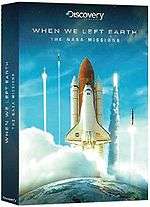When We Left Earth: The NASA Missions
| When We Left Earth: The NASA Missions | |
|---|---|
|
DVD/Blu-ray case | |
| Genre | Documentary, science, space exploration, historical |
| Narrated by | Gary Sinise |
| Country of origin | United States |
| Original language(s) | English |
| No. of episodes | 6 |
| Production | |
| Running time | 6 hours (6 1-hour-long episodes, originally aired as a double bill) |
| Release | |
| Original network | Discovery Channel |
| Original release | June 8, 2008 |
| External links | |
| Website | |
When We Left Earth: The NASA Missions or NASA's Greatest Missions: When We Left Earth in the UK is a Discovery Channel HD documentary miniseries consisting of six episodes documenting American human spaceflight, spanning from the first Mercury flights through the Gemini program to the Apollo moon landings, the Space Shuttle, and the construction of the International Space Station. It was created in association with NASA to commemorate the agency's fiftieth anniversary in 2008. It first aired on June 8, 2008, and concluded on June 22. Each airing consisted of two hour-long episodes.
The miniseries was released on DVD on July 10, 2008, and was released on Blu-ray disc on August 12.[1]
The third episode, "Landing the Eagle", was re-aired on July 20, 2009 for the 40th anniversary of the Apollo 11 moon landing.[2] It featured improved images from the moonwalk.
Overview
The miniseries features interviews from Mercury, Gemini, Apollo, and Space Shuttle astronauts including John Glenn and Neil Armstrong, as well as NASA officials including flight directors Chris Kraft, Gene Kranz, and Glynn Lunney, former president George H. W. Bush and long-time NBC space journalist Jay Barbree.
The series is narrated by actor Gary Sinise, who played astronaut Ken Mattingly in the 1995 film Apollo 13, and executive produced by Richard Dale and Bill Howard, edited by Peter Parnham and Simon Holland.
Music
The score was composed by Richard Blair-Oliphant and conducted by Ben Wallfisch (Atonement 2007, The Soloist 2009). Music and sound was nominated for a 2009 News and Documentary Emmy Award for Outstanding Individual Achievement in Music and Sound.
Episodes
Part 1: Ordinary Supermen
The first episode of the series documents the start of the Space Race and the flights of the Mercury Program, beginning with flight testing of the X-15 rocket plane, Alan Shepard's flight as the first American astronaut aboard Freedom 7, and John Glenn's historic flight Friendship 7 and the potentially fatal problem with the heatshield that occurred during the second orbit. Neil Armstrong, Chris Kraft, Glynn Lunney, Gene Kranz, and NBC News space correspondent Jay Barbree are among those interviewed.
Part 2: Friends and Rivals
The second episode is centered on Project Gemini, the second American human spaceflight program. It features the first American spacewalk by Gemini 4 astronaut Ed White. It also features the first space rendezvous with Gemini 6 and 7 and a two-week-long mission on Gemini 7. It also includes the first docking in space on Gemini 8 and the first mission abort in space, also on Gemini 8. Lastly, it shows the first American to conduct an EVA, or Extra-vehicular activity, Ed White.
Part 3: Landing the Eagle
The third episode details the beginning of the Apollo program, starting with rocket engine testing of the F-1 engines, the Apollo 1 disaster, the flights of Apollo 8, 9, and 10, the tense lunar descent of Apollo 11, and the first human footsteps on the lunar surface. Both Buzz Aldrin and the rarely interviewed Neil Armstrong appear in the episode, as well as all of the Apollo 8 astronauts, Commander Jim McDivitt of Apollo 9, Apollo 10 astronauts Gene Cernan and John Young, and capsule communicators Charlie Duke and Bruce McCandless II and flight director Gene Kranz.
Part 4: The Explorers
The fourth episode features the five other successful moon landings - Apollos 12, 14, 15, 16, and 17, as well as the "successful failure" of Apollo 13. It also features the space station Skylab.
Part 5: The Shuttle
The penultimate episode focuses on the flights of the Space Shuttle, beginning with Columbia's maiden voyage on April 12, 1981 (the twentieth anniversary of the first human spaceflight, Vostok 1). The STS-1 crew, commander John Young, and pilot Bob Crippen, are interviewed. Bruce McCandless's untethered spacewalk on STS-41-B - the first in history - is shown digitally remastered in high-definition. The episode also documents the Space Shuttle Challenger disaster that occurred 73 seconds after lift-off on mission STS-51-L, on January 28, 1986, and the subsequent halt of the Space Shuttle program. The episode ends with the launch of the Hubble Space Telescope in 1990 on mission STS-31 and the subsequent discovery of its defective mirror.
Part 6: A Home in Space
The series' final episode centers on the first refurbishment mission of the Hubble Space Telescope, and launch, assembly, and construction of the International Space Station. Shuttle astronauts, including Scott Altman, Michael Lopez-Alegria (the US record holder for number and duration of spacewalks), Ken Bowersox, and Eileen Collins, are featured in the episode. The episode also recalls the Space Shuttle Columbia disaster that occurred during re-entry, 16 minutes from landing at the Kennedy Space Center, on mission STS-107, on February 1, 2003.
See also
References
External links
- Official Discovery Channel website
- When We Left Earth: The NASA Missions at the Internet Movie Database
